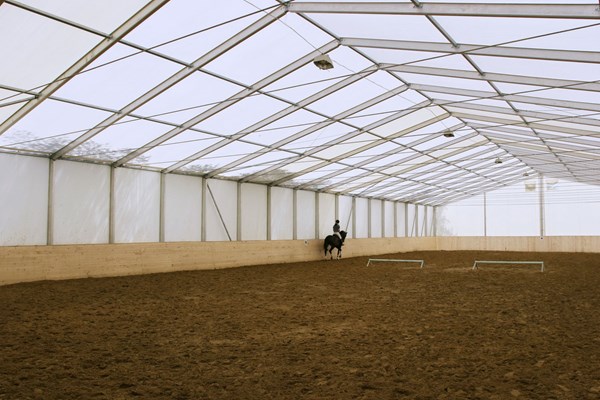 Credit: Thinkstock The biggest benefit of the fabric roof is the ethereal lighting that occurs on the inside as daylight diffuses through the fabric cover.
Credit: Thinkstock The biggest benefit of the fabric roof is the ethereal lighting that occurs on the inside as daylight diffuses through the fabric cover.Fabric-roofed arenas are known colloquially as “coveralls” although this is misleading because Coverall is a specific manufacturer. There are other manufacturers that specialize in these structures as well.
Fabric-roofed structures are typically assembled as follows:
A prefabricated, steel galvanized, ladder-type frame is used for the roof structure, over which a fabric cover is stretched. This roof system may be contiguous with the wall system so that the fabric continues to the ground, or it may be set higher up on top of a half or full wall.
Fabric buildings, while prefabricated, may be similar in cost or much more expensive than a metal building, depending on the system, size, and manufacturer. It is not uncommon for these fabric structures to cost as much as the low to medium end of custom built arenas.
For areas that receive heavy snows, we prefer the fabric structures that are manufactured in Canada because they are designed to resist large snow loads without too much deflection or failure.
The biggest benefit of the fabric roof is the ethereal lighting that occurs on the inside as daylight diffuses through the fabric cover. There is nothing like it! For dark, austere winter climates, a fabric roof structure can be a welcome break from otherwise darker, depressing interior spaces. Fabric roofs also breathe a little more naturally, creating a healthier indoor air space, which helps to supplement ventilation openings.
One downside of fabric-roofed arenas is that they can look somewhat unattractive from the outside, like a temporary tent or utilitarian agricultural structure. To avoid that look, consider a hybrid structure that has solid sides and a fabric roof, so that the structure feels and looks more like a regular arena with a daylit roof.
Editor’s note: You can find the other articles in this series on Equestrian Arena Options by searching Articles>Barns & Grounds in our top dropdown menu.


